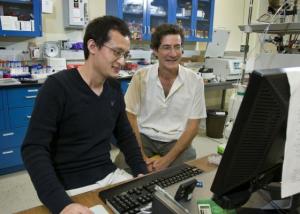ScienceDaily (Oct. 4, 2010) — UCLA physicists have taken a significant step in controlling chemical reactions mechanically, an important advance in nanotechnology, UCLA physics professor Giovanni Zocchi and colleagues report.
But the molecules have to collide in a certain way for the reaction to occur. The enzyme binds to the molecules and lines them up, forcing them to collide in the "right" way, so the probability that the molecules will exchange atoms is much higher.
"Instead of just watching what the molecules do, we can mechanically prod them," said Zocchi, the senior author of the research.
To do that, Zocchi and his graduate students, Chiao-Yu Tseng and Andrew Wang, attached a controllable molecular spring made of DNA to the enzyme. The spring is about 10,000 times smaller than the diameter of a human hair. They can mechanically turn the enzyme on and off and control how fast the chemical reaction occurs. In their newest research, they attached the molecular spring at three different locations on the enzyme and were able to mechanically influence different specific steps of the reaction.
They published their research in the journal Europhysics Letters, a publication of the European Physical Society, in July.
"We have stressed the enzyme in different ways," Zocchi said. "We can measure the effect on the chemical reaction of stressing the molecule this way or that way. Stressing the molecule in different locations produces different responses. If you attach the molecular spring in one place, nothing much happens to the chemical reaction, but you attach it to a different place and you affect one step in the chemical reaction. Then you attach it to a third place and affect another step in this chemical reaction."
Zocchi, Tseng and Wang studied the rate of the chemical reactions and reported in detail what happened to the steps of the reactions as they applied mechanical stress to the enzyme at different places.
"Standing on the shoulders of 50 years of structural studies of proteins, we looked beyond the structural description at the dynamics, specifically the question of what forces -- and applied where -- have what effect on the reaction rates," Zocchi said.
In a related second paper, Zocchi and his colleagues reached a surprising conclusion in solving a longstanding physics puzzle.
When one bends a straight tree branch or a straight rod by compressing it longitudinally, the branch or rod at first remains straight and does not bend until a certain critical force is exceeded. At the critical force, it does not bend a little -- it suddenly buckles and bends a lot.
"This phenomenon is well known to any child who has made bows from hazelnut bush branches, for example, which are typically quite straight. To string the bow, you have to press down on it hard to buckle it, but once it is bent, you need only a smaller force to keep it so," Zocchi said.
The UCLA physicists studied the elastic energy of their DNA molecular spring when it is sharply bent.
"Such a short double-stranded DNA molecule is somewhat similar to a rod, but the elasticity of DNA at this scale was not known," Zocchi said. "What is the force the DNA molecular spring is exerting on the enzyme? We have answered this question.
"We find there is a similar bifurcation with this DNA molecule. It goes from being bent smoothly to having a kink. When we bend this molecule, there is a critical force where there is a qualitative difference. The molecule is like the tree branch and the rod in this respect. If you're just a little below the threshold, the system has one kind of behavior; if you're just a little above the threshold force, the behavior is totally different. The achievement was to measure directly the elastic energy of this stressed molecule, and from the elastic energy characterize the kink."
Co-authors on this research are UCLA physics graduate students Hao Qu, Chiao-Yu Tseng and Yong Wang and UCLA associate professor of chemistry and biochemistry Alexander Levine, who is a member of the California NanoSystems Institute at UCLA. The research was published in April, also in the journal Europhysics Letters.
"We can now measure for any specific DNA molecule what the elastic energy threshold for the instability is," Zocchi said. "I see beauty in this important phenomenon. How is it possible that the same principle applies to a tree branch and to a molecule? Yet it does. The essence of physics is finding common behavior in systems that seem very different."
While Zocchi's research may have applications for medicine and other fields, he emphasizes the advance in knowledge itself.
"There is value in science that adds to our knowledge and helps us understand our world, apart from the value of future applications," he said. "I study problems that I find interesting, where I think I can make a contribution. Why study a particular problem rather than another? Perhaps for the same reason a painter chooses a particular landscape. Perhaps we see beauty there."
Story Source:
The above story is reprinted (with editorial adaptations by ScienceDaily staff) from materials provided by University of California -- Los Angeles. The original article was written by Stuart Wolpert.
Journal References:
- C.-Y. Tseng, A. Wang, G. Zocchi. Mechano-chemistry of the enzyme Guanylate Kinase. EPL (Europhysics Letters), 2010; 91 (1): 18005 DOI: 10.1209/0295-5075/91/18005
- Hao Qu, Chiao-Yu Tseng, Yong Wang, Alex J. Levine, Giovanni Zocchi. The elastic energy of sharply bent nicked DNA. EPL (Europhysics Letters), 2010; 90 (1): 18003 DOI: 10.1209/0295-5075/90/18003

